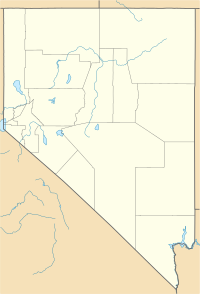Fly Geyser
| Fly Geyser | |
|---|---|
 | |
| Name origin | Named after Fly Ranch |
| Location | Fly Ranch, Washoe County, Nevada |
| Coordinates | 40°51′34″N 119°19′55″W / 40.85944°N 119.33194°W / 40.85944; -119.33194 |
| Elevation | 4,014 feet (1,223 m) |
| Type | Cone-type geyser |
| Eruption height | 5 feet (1.5 m) and growing |
| Frequency | Constant |
| Duration | Constant |
| Temperature | 93.0 °C (199.4 °F) |
Fly Geyser, also known as Fly Ranch Geyser is a small geothermal geyser located on private land in Washoe County, Nevada, about 20 miles (32 km) north of Gerlach. Fly Geyser is located near the edge of Fly Reservoir in the Hualapai Geothermal Flats and is approximately 5 feet (1.5 m) high by 12 feet (3.7 m) wide, counting the mound on which it sits.
In June 2016, the non-profit Burning Man Project purchased the 3,800 acres (1,500 ha) Fly Ranch, including the geyser, for $6.5 million.[1][2] The Burning Man Project began offering limited public access to the property in May 2018.[3] The geyser contains thermophilic algae, which flourish in moist, hot environments, resulting in multiple hues of green and red, coloring the rocks.
Location
Fly Geyser is located on the Fly Ranch in Hualapai Flat, about 0.3 miles (0.48 km) from State Route 34[4] and about 25 miles (40 km) north of Gerlach, Nevada. It is east of Black Rock Desert.
Origin
The source of the Fly Geyser field's heat is attributed to a very deep pool of hot rock where tectonic rifting and faulting are common.
The first geyser at the site was formed in 1916 when a well was drilled seeking irrigation water. When geothermal water at close to boiling point was found, the well was abandoned, and a 10–12-foot (3.0–3.7 m) calcium carbonate cone formed.[5]
In 1964, a geothermal energy company drilled a second well near the site of the first well.[5] The water was not hot enough for energy purposes. They reportedly capped the well, but the seal failed. The discharge from the second well released sufficient pressure that the original geyser dried up.[5][6] Dissolved minerals in the water, including calcium carbonate and silica, accumulated around the new geyser, creating the cones and travertine pools.[6]
The geyser has multiple conic openings sitting on a mound: the cones are about 6 feet (1.8 m), and the entire mound is 25 to 30 feet (7.6 to 9.1 m) tall.

Characteristics
The temperature of the water exiting the geyser can exceed 200 °F (93 °C),[9] which is typical for geysers at high elevation.[10]
Carolina Muñoz Saez, who was hired by the Burning Man owners to study the geyser, reported that the geyser contains "a really high amount of silica." The silica combined with the temperature has caused quartz to form inside the geyser extraordinarily quickly. Quartz typically takes up to 10,000 years to develop in geysers.[9] Saez said the Fly Geyser is unlike any other geyser she has studied.[9]
Water is constantly released, reaching 5 feet (1.5 m) in the air.[4] The geyser has formed several travertine terraces, creating 30 to 40 pools over an area of 74 acres (30 ha).[11] The water produced by the geyser contains thermophilic algae, which flourish in moist, hot environments, coloring the rocks with brilliant hues of green and red.[5][6]
Public access
Fly Ranch is open to small, guided three-hour nature walks from April to October of each year.[9] The geyser is part of the nature walk. Tours are managed and led by the Friends of Black Rock-High Rock.[12][13]
Payments for tickets for the walk are considered to be donations and are used to support Fly Ranch and the Friends organization.[12]
Other local geysers
A prior well-drilling attempt in 1917 resulted in the creation of a geyser close to the currently active Fly Geyser; it created a pillar of calcium carbonate about 12 feet (3.7 m) tall, but ceased when the Fly Geyser began releasing water in 1964.[6]
References
- ^ "Fly Ranch - Burning Man Project". burningman.org.
- ^ "We Bought Fly Ranch". Burning Man Journal. Retrieved 2017-11-08.
- ^ "Fly Ranch - Burning Man Project". Fly Ranch - Burning Man Project. Retrieved 2017-11-08.
- ^ a b "Fly Geyser". CmdrMark.com. Archived from the original on 2017-08-27. Retrieved 2010-06-01.
- ^ a b c d Fly Gerser
- ^ a b c d Richard Moreno (4 November 2008). Nevada Curiosities: Quirky Characters, Roadside Oddities & Other Offbeat Stuff. Globe Pequot Press. pp. 104–. ISBN 978-0-7627-4682-8. Retrieved 15 July 2013.
- ^ "Fly Geyser". Travels in the American Southwest. CmdrMark.com. 2003-08-23. Archived from the original on 2017-08-27. Retrieved 2014-11-08.
- ^ Leininger, Merrie. "Playa playground - indulge your primitive side at Northern Nevada's Black Rock Desert". Nevada Magazine. Archived from the original on 2011-07-14. Retrieved 2008-10-13.
- ^ a b c d Zee, Brenda (April 6, 2018) "Fly Geyser Opens To Public For First Time In Two Decades" KUNR
- ^ Rinehart, John S. (2012-12-06). Geysers and Geothermal Energy. Springer Science & Business Media. ISBN 978-1-4612-6084-4.
- ^ "Fly Geyser". FlyGeyser.org. Archived from the original on 2010-06-20. Retrieved 2010-06-01.
- ^ a b FLY GEYSER NEVADA TOUR – WHAT YOU NEED TO KNOW BEFORE YOU GO
- ^ Fly Geyser
External links
- Fly Geyser Archived 2019-04-17 at the Wayback Machine (in German)
- "Fly Geyser". Friends of Black Rock High Rock.
- "Fly Geyser Nevada". All Over the Map. Archived from the original on 2011-12-09. Retrieved 2010-09-07.
- Images and background of Fly Geyser
- Fly Ranch-Burning Man Project

